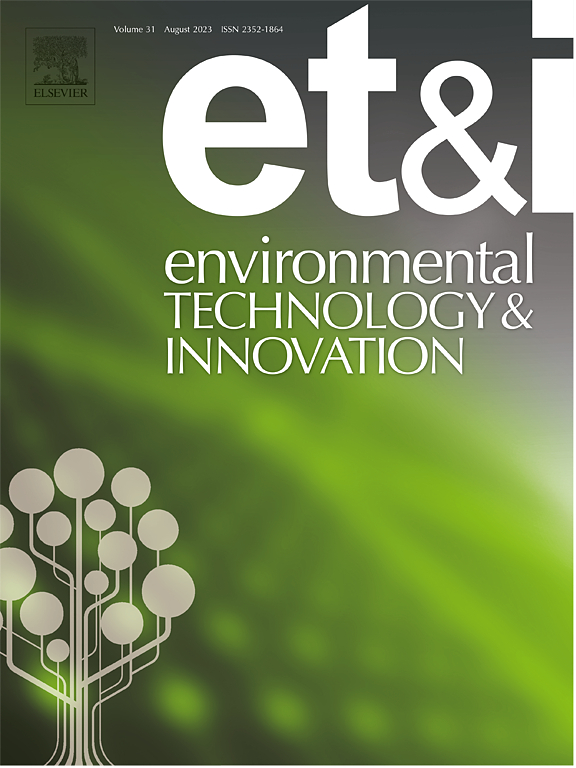通过crispr辅助工程推进尼龙单体的生物循环利用
IF 6.7
2区 环境科学与生态学
Q1 BIOTECHNOLOGY & APPLIED MICROBIOLOGY
引用次数: 0
摘要
塑料垃圾是一个全球性的环境危机,尼龙——一种广泛使用的聚酰胺——由于其在纺织品、汽车零部件和包装中的广泛应用而起着重要作用。尼龙在生命周期后降解会释放出1,6-六亚二胺(HD)和6-氨基己酸(ACA)等单体,这些单体在生态系统中持续存在,具有毒性和生物蓄积风险。在这项研究中,我们采用crispr辅助定向进化(CDE)技术改造恶臭假单胞菌KT2440,使其高效利用HD作为唯一的氮源,并将其降解与细菌生长结合起来。基因组学和转录组学分析优先考虑了参与HD降解的潜在酶。利用CRISPR干扰(CRISPRi)和专家指导筛选,我们确定了KgtP转运蛋白、AlaC转氨酶和FrmA脱氢酶这三种对KAF通路至关重要的关键酶。这些酶的功能在恶臭杆菌中得到证实,并通过大肠杆菌的外源表达进一步验证。CDE和生长耦合策略,以及我们发现的KAF途径,对于我们未来设计能够降解混合塑料单体的细菌联合体的努力至关重要。从长远来看,我们设想将这些联盟与合成生物学工具结合起来,降解复杂的塑料聚合物并将其转化为有价值的化学品,推进循环经济努力,实现可持续的塑料废物管理和环境保护。crispr系统设计了恶臭假单胞菌,用于高效的尼龙单体降解,揭示了一种新的途径,并推进了塑料废物回收和环境缓解策略。本文章由计算机程序翻译,如有差异,请以英文原文为准。
Advancing bio-recycling of nylon monomers through CRISPR-assisted engineering
Plastic waste is a global environmental crisis, and nylon—a widely used polyamide—contributing significantly due to its extensive applications in textiles, automotive components, and packaging. Post-lifecycle degradation of nylon releases monomers like 1,6-hexamethylenediamine (HD) and 6-aminocaproic acid (ACA), which persist in ecosystems, posing toxicity and bioaccumulation risks. In this study, we employed a CRISPR-assisted directed evolution (CDE) to engineer Pseudomonas putida KT2440 for efficient utilization of HD as the sole nitrogen source, coupling its degradation to bacterial growth. Genomic and transcriptomic analyses prioritized potential enzymes involved in HD degradation. Using CRISPR interference (CRISPRi) and expert-guided screening, we identified three key enzymes including KgtP transporter, AlaC transaminase, and FrmA dehydrogenase that are critical to the KAF pathway. The functionality of these enzymes was confirmed in P. putida and further validated through heterologous expression in Escherichia coli. The CDE and growth-coupled strategy, together with the KAF pathway we discovered, is essential for our future efforts to engineer synthetic bacterial consortia capable of degrading mixed plastic monomers. In the long term, we envision integrating these consortia with synthetic biology tools to degrade complex plastic polymers and convert them into valuable chemicals, advancing circular economic efforts for sustainable plastic waste management and environmental protection.
Synopsis
CRISPR systems engineered Pseudomonas putida for efficient nylon monomer degradation, unveiling a novel pathway and advancing plastic waste recycling and environmental mitigation strategies.
求助全文
通过发布文献求助,成功后即可免费获取论文全文。
去求助
来源期刊

Environmental Technology & Innovation
Environmental Science-General Environmental Science
CiteScore
14.00
自引率
4.20%
发文量
435
审稿时长
74 days
期刊介绍:
Environmental Technology & Innovation adopts a challenge-oriented approach to solutions by integrating natural sciences to promote a sustainable future. The journal aims to foster the creation and development of innovative products, technologies, and ideas that enhance the environment, with impacts across soil, air, water, and food in rural and urban areas.
As a platform for disseminating scientific evidence for environmental protection and sustainable development, the journal emphasizes fundamental science, methodologies, tools, techniques, and policy considerations. It emphasizes the importance of science and technology in environmental benefits, including smarter, cleaner technologies for environmental protection, more efficient resource processing methods, and the evidence supporting their effectiveness.
 求助内容:
求助内容: 应助结果提醒方式:
应助结果提醒方式:


